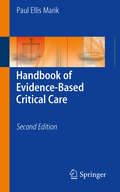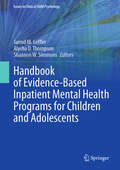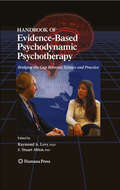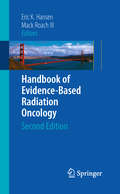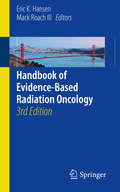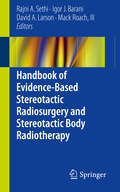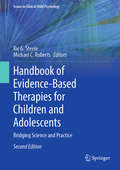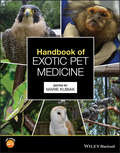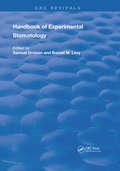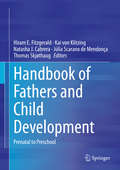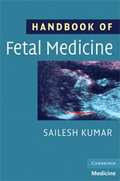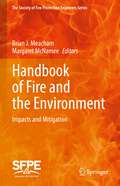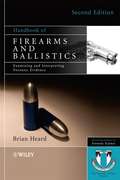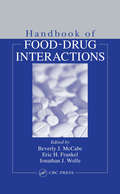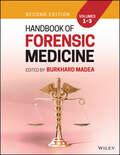- Table View
- List View
Handbook of Evidence-Based Critical Care
by Paul Ellis MarikThis updated and revised edition of the classic bedside pocket reference remains the gold standard in critical care medicine. The new edition maintains Dr. Marik's trademark humor and engaging writing style, while adding numerous references to make this book the most current and thorough treatment of evidence-based critical care available. The handbook enables the clinician to find the evidence to support or refute an intervention and to help choose the most appropriate, cost-effective treatment. The analysis of treatment strategies is presented by organ system, and the handbook also covers miscellaneous ICU topics (such as sedation, toxicology, radiology, and sepsis) based on the most frequently found and difficult to solve problems in ICU patient management.
Handbook of Evidence-Based Day Treatment Programs for Children and Adolescents (Issues in Clinical Child Psychology)
by Jarrod M. Leffler Elisabeth A. FrazierThis book examines the intermediate level of mental health services with a focus on partial hospitalization program (PHP) and intensive outpatient program (IOP) models of care for youth. It reviews the history of PHPs and IOPs and highlights their current care models, demonstrating the increase in the development and implementation of evidence-based treatment (EBT) practices. The book explores issues relating to program development, implementation, and considerations for sustainability. It provides interventions designed to enhance the well-being of youth who are experiencing a range of mental health concerns as well as strategies to engage and involve their families. In addition, the book offers feasible strategies for measuring outcomes and applying these results to meaningful clinical evaluations in PHP and IOP settings. It describes the process of accessing and using these intermediate services as well as additional treatment resources that may be necessary in the continuum of mental health care for youth. Key areas of coverage include: The history and purpose of mental health care and the role of day treatment programs for youth.Working with program administration and other stakeholders, identifying a patient population, and engaging community and referral sources.The importance of family involvement, coordination of care, and simultaneously addressing the transactional relationship between physical and mental health.Transitioning youth from pediatric mental health services into the adult mental health system.Working with a diverse patient population in intermediate treatment programs.Providing practical information for families and practitioners navigating the pediatric mental health continuum of care. The Handbook of Evidence-Based Day Treatment Programs for Children and Adolescents is a must-have resource for researchers, professors, and graduate students as well as clinicians, therapists, course instructors, and other professionals in child and adolescent psychiatry, clinical child and school psychology, social work, counseling, public health, family studies, developmental psychology, pediatrics, and all related disciplines.
Handbook of Evidence-Based Inpatient Mental Health Programs for Children and Adolescents (Issues in Clinical Child Psychology)
by Jarrod M. Leffler Alysha D. Thompson Shannon W. SimmonsThis book reviews the history of inpatient psychiatric hospital (IPH) and acute mental health services for youth. In addition, it highlights current IPH care models for children and adolescents, demonstrating an increase in the development and implementation of evidence-based-informed (EBI) treatments in IPH and acute care settings. The book offers insights into program development, implementation, and measurement as well as considerations for sustainability. Chapters describe interventions designed to enhance the well-being of youth and their families who are experiencing a range of mental health concerns. The book shares practicable strategies for measuring outcomes and applying these results to meaningful clinical outcomes in IPH and acute care settings. It also provides treatment referral resources and information about the process of accessing and using such services. Finally, the book reviews additional treatment resources that may be necessary in the continuum of mental health care for youth. Key areas of coverage include: Developing and constructing the physical and safety environment of an IPH unit and suicide and safety planning. Setting and monitoring treatment goals and discharge criteria. Equity, diversity, and inclusion considerations in psychiatric inpatient units. Program operations and therapy on a psychiatric inpatient unit for youth diagnosed with neurodevelopmental disorders. Disaster preparation and impact on inpatient psychiatric care. The Handbook of Evidence-Based Inpatient Mental Health Programs for Children and Adolescents is a must-have resource for researchers, professors, and graduate students as well as clinicians, therapists, and other professionals in developmental, clinical child, developmental, and school psychology, social work, public health, child and adolescent psychiatry, family studies, pediatrics, and all related disciplines.
Handbook of Evidence-Based Practices in Autism Spectrum Disorder
by Fred R. Volkmar Peter Doehring Brian ReichowThe handbook examines the empirical status of interventions and treatments for individuals with autism spectrum disorder (ASD). It offers an insightful and balanced perspective on topics ranging from the historical underpinnings of autism treatment to the use of psychopharmacology and the implementation of EBPs. The book reviews the conceptualization of evidence-based practices (EBPs) as well as considerations for implementing such practices across settings. In addition, it describes emerging treatments – though they cannot yet be considered evidence-based – that have produced limited but highly promising results. The book also describes treatments and therapies that have been proved ineffective. It explores ways in which EBPs can be applied in inclusive school settings, pedatric settings, in-patient treatment progams, and college-based programs for transition-aged youth. The volume describes outcomes from the development of EBP guidelines at the national level (in Scotland) and, more broadly, in the United States and outlines how such guidelines can be adapted to offer more individualized intervention. Key areas of coverage include: Comprehensive treatment models, including early intensive behavioral intervention, pivotal response treatment, Early Start Denver Model, and Naturalistic Developmental Behavioral Interventions. Focal treatments addressing the core deficits of ASD and its co-occuring conditions. Social skills, communication, and the use of applied behavior analysis (ABA) practices for teaching new skills and decreasing challenging behaviors. Sensory-based interventions, psychopharmacology, cognitive behavior therapy, and parent education programs (e.g., Project ImPACT). The Handbook of Evidence-Based Practices in Autism Spectrum Disorder is an invaluable resource for researchers, professors, and graduate students as well as clinicians, therapists, and all professionals working in the fields of developmental, clinical child, and school psychology, pediatrics, social work, behavior analysis, allied health sciences, public health, child and adolescent psychiatry, early childhood intervention, and general and special education.
Handbook of Evidence-Based Psychodynamic Psychotherapy
by J. Stuart Ablon G. O. Gabbard Raymond A. LevyThe importance of conducting empirical research for the future of psychodynamics is presented in this excellent new volume. In Handbook of Evidence Based Psychodynamic Psychotherapy: Bridging the Gap Between Science and Practice, the editors provide evidence that supports this type of research for two primary reasons. The first reason concerns the current marginalization of psychodynamic work within the mental health field. Sound empirical research has the potential to affirm the important role that psychodynamic theory and treatment have in modern psychiatry and psychology. The second reason that research is crucial to the future of psychodynamic work concerns the role that systematic empirical investigations can have in developing and refining effective approaches to a variety of clinical problems. Empirical research functions as a check on subjectivity and theoretical alliances in on-going attempts to determine the approaches most helpful in working with patients clinically. Handbook of Evidence Based Psychodynamic Psychotherapy: Bridging the Gap Between Science and Practice brings together a panel of distinguished clinician-researchers who have been publishing their findings for decades. This important new book provides compelling evidence that psychodynamic psychotherapy is an effective treatment for many common psychological problems.
Handbook of Evidence-Based Radiation Oncology
by Mack Roach III Eric HansenBuilding on the success of this book's first edition, Dr. Eric Hansen and Dr. Mack Roach have updated, revised, and expanded the Handbook of Evidence-based Radiation Oncology, a portable reference that utilizes evidence-based medicine as the basis for practical treatment recommendations and guidelines. Organized by body site, concise clinical chapters provide easy access to critical information. Important "pearls" of epidemiology, anatomy, pathology, and clinical presentation are highlighted. Key facets of the work-up are listed, followed by staging and/or risk classification systems. Treatment recommendations are discussed based on stage, histology, and/or risk classification. Brief summaries of key trials and studies provide rationale for the recommendations. Practical guidelines for radiation techniques are described. Finally, complications and follow-up guidelines are outlined. Updates from the first edition include brand new color figures and color contouring mini-atlases for head and neck, gastrointestinal, prostate, and gynecological tumors; redesigned tables for increased readability; new chapters on management of the neck and unknown primary, clinical radiobiology, and pediatric malignancies and benign conditions; and new appendices including the American College of Radiology guidelines for administration of IV contrast.
Handbook of Evidence-Based Radiation Oncology
by Eric K. Hansen Jeffery D. LongThe Third Edition of Handbook of Evidence-Based Radiation Oncology updates and revises the previous successful editions and serves as a key reference for radiation oncology professionals. Organized by body site, concise clinical chapters provide easy access to critical information. Important "pearls" of epidemiology, anatomy, pathology, and clinical presentation are highlighted. The key elements of the work-up are listed, followed by staging and/or risk classification systems. Treatment recommendations are discussed based on stage, histology, and/or risk classification. Brief summaries of key trials and studies provide the rationale for the recommendations. Practical guidelines for radiation techniques are described and complications and follow-up guidelines are outlined. The Third Edition incorporates new key studies and trials to reflect current radiation oncology practice; includes the most recent staging systems; and features new color illustrations and anatomic atlases to aid in treatment planning. This book is a valuable resource for students, resident physicians, fellows, and other practitioners of radiation oncology.
Handbook of Evidence-Based Stereotactic Radiosurgery and Stereotactic Body Radiotherapy
by III Rajni A. Sethi Igor J. Barani David A. Larson Mack RoachThis handbook concisely summarizes state-of-the-art information about stereotactic radiosurgery (SRS) and stereotactic body radiotherapy (SBRT), including the history and development of these modalities, the biologic rationale for these technologies, typical practices, and reported results. Developed as a companion to Handbook of Evidence-Based Radiotherapy, Second Edition, edited by Eric Hansen and Mack Roach, III, it is organized by disease site and presents treatment techniques and recommended imaging; safety and quality assurance; toxicities and management; recommended follow-up; and supporting evidence. Inclusion of evidence-based guidelines is intended to help inform decisions regarding the appropriateness of SRS and SBRT and guide treatment and evaluation. Handbook of Evidence-Based Stereotactic Radiosurgery and Stereotactic Body Radiotherapy can be easily referenced in the clinic and is a valuable guide for oncology practitioners.
Handbook of Evidence-Based Stereotactic Radiosurgery and Stereotactic Body Radiotherapy
by Mack Roach III Rajni A. Sethi Igor J. Barani David A. LarsonThis handbook concisely summarizes state-of-the-art information about stereotactic radiosurgery (SRS) and stereotactic body radiotherapy (SBRT), including the history and development of these modalities, the biologic rationale for these technologies, typical practices, and reported results. Developed as a companion to Handbook of Evidence-Based Radiation Oncology, edited by Eric Hansen and Mack Roach, III, it is organized by disease site and presents treatment techniques and recommended imaging; safety and quality assurance; toxicities and management; recommended follow-up; and supporting evidence. Inclusion of evidence-based guidelines is intended to help inform decisions regarding the appropriateness of SRS and SBRT and guide treatment and evaluation. This new edition is fully updated with the latest literature. A new chapter on dose constraints has also been added, along with additional content on SBRT for oligometastatic disease and prostate, and the integration of SBRT with systemic therapy, including chemotherapy, immunotherapy, targeted agents. Case examples are added, as well as additional images to highlight situations described. Handbook of Evidence-Based Stereotactic Radiosurgery and Stereotactic Body Radiotherapy, 2e can be easily referenced in the clinic and is a valuable guide for radiation oncology practitioners
Handbook of Evidence-Based Therapies for Children and Adolescents: Bridging Science and Practice (Issues in Clinical Child Psychology)
by Michael C. Roberts Ric G. SteeleThe comprehensive coverage in this hugely important and timely handbook makes it invaluable to clinical child, school, and counseling psychologists; clinical social workers; and child psychiatrists. As a textbook for advanced clinical and counseling psychology programs, and a solid reference for the researcher in child/adolescent mental health, its emphasis on flexibility and attention to emerging issues will help readers meet ongoing challenges, as well as advance the field. Its relevance cannot be overstated, as growing numbers of young people have mental health problems requiring intervention, and current policy initiatives identify evidence-based therapies as the most effective and relevant forms of treatment.
Handbook of Exotic Pet Medicine
by Marie KubiakEasy-to-use, comprehensive reference covering the less common species encountered in general veterinary practice Handbook of Exotic Pet Medicine provides easy-to-access, detailed information on a wide variety of exotic species that can be encountered in general veterinary practice. Offering excellent coverage of topics such as basic techniques, preventative health measures, and a formulary for each species, each chapter uses the same easy-to-follow format so that users can find information quickly while working in the clinic. Presented in full colour, with over 400 photographs, the book gives small animal practitioners the confidence to handle and treat more familiar pets such as budgerigars, African grey parrots, bearded dragons, corn snakes, tortoises, pygmy hedgehogs, hamsters and rats. Other species that may be presented less frequently including skunks, marmosets, sugar gliders, koi carp, chameleons and terrapins are also covered in detail to enable clinicians to quickly access relevant information. Provides comprehensive coverage of many exotic pet species that veterinarians may encounter in general practice situations Presents evidence-based discussions of topics including biological parameters, husbandry, clinical evaluation, hospitalization requirements, common medical and surgical conditions, radiographic imaging, and more The Handbook of Exotic Pet Medicine is an ideal one-stop reference for the busy general practitioner seeing the occasional exotic animal, veterinary surgeons with an established exotic animal caseload, veterinary students and veterinary nurses wishing to further their knowledge.
Handbook of Experimental Stomatology (Routledge Revivals)
by Samuel Dreizen, D.D.S., M.D., Barnet M. Levy, D.D.S., M.S. and Barnet M. LevyFirst Published in 1981, this book offers a full, comprehensive guide to experimental stomatology. Carefully compiled and filled with a vast repertoire of notes, diagrams, and references this book serves as a useful reference for students of medicine, and other practitioners in their respective fields.
Handbook of Face Recognition
by Stan Z. Li Anil K. Jain Jiankang DengThe history of computer-aided face recognition dates to the 1960s, yet the problem of automatic face recognition – a task that humans perform routinely and effortlessly in our daily lives – still poses great challenges, especially in unconstrained conditions.This highly anticipated new edition provides a comprehensive account of face recognition research and technology, spanning the full range of topics needed for designing operational recognition systems. After a thorough introduction, each subsequent chapter focuses on a specific topic, reviewing background information, up-to-date techniques, and recent results, as well as offering challenges and future directions.Topics and features:Fully updated, revised, and expanded, covering the entire spectrum of concepts, methods, and algorithms for automated detection and recognition systemsProvides comprehensive coverage of face detection, alignment, feature extraction, and recognition technologies, and issues in evaluation, systems, security, and applicationsContains numerous step-by-step algorithmsDescribes a broad range of applications from person verification, surveillance, and security, to entertainmentPresents contributions from an international selection of preeminent expertsIntegrates numerous supporting graphs, tables, charts, and performance dataThis practical and authoritative reference is an essential resource for researchers, professionals and students involved in image processing, computer vision, biometrics, security, Internet, mobile devices, human-computer interface, E-services, computer graphics and animation, and the computer game industry.
Handbook of Fathers and Child Development: Prenatal to Preschool
by Natasha J. Cabrera Hiram E. Fitzgerald Kai Von Klitzing Júlia Scarano de Mendonça Thomas SkjøthaugThis handbook provides a comprehensive review of the impact of fathers on child development from prenatal years to age five. It examines the effects of the father-child relationship on the child’s neurobiological development; hormonal, emotional and behavioral regulatory systems; and on the systemic embodiment of experiences into the child’s mental models of self, others, and self-other relationships. The volume reflects two perspectives guiding research with fathers: Identifying positive and negative factors that influence early childhood development, specifying child outcomes, and emphasizing cultural diversity in father involvement; and examining multifaceted, specific approaches to guide father research. Key topics addressed include: Direct assessment of father parenting (rather than through maternal reports).The effects of father presence (in contrast to father absence).The full diversity of father involvement.Father’s impact on gender role differentiation.Father’s role in triadic interactions of family dynamics.Father involvement in psychotherapeutic family interventions. This handbook draws from converging perspectives about the role of fathers in very early child development, summarizes what is known, and, within each chapter, draws attention to the critical questions that need to be answered in coming decades.The Handbook of Fathers and Child Development is a must-have resource for researchers, graduate students, and clinicians, therapists, and other professionals in infancy and early child development, social work, public health, developmental and clinical child psychology, pediatrics, family studies, neuroscience, juvenile justice, child and adolescent psychiatry, school and educational psychology, anthropology, sociology, and all interrelated disciplines.
Handbook of Fetal Medicine
by Sailesh KumarHandbook of Fetal Medicine provides a concise and practical guide to the modern management of normal pregnancy and the at-risk fetus. Comprehensive in scope, in an easy-to-use format, the book provides guidance on a wide range of conditions, best practice management strategies and treatment options in maternal-fetal medicine. Each system-based chapter has a brief introduction on embryology and discusses the key genetic developments and relevant developmental abnormalities. The book begins by addressing genetic disorders such as Down syndrome, and goes on to consider skeletal and bodily system abnormalities. All key management points are highlighted and data on long-term outcomes are provided. This book will appeal to maternal-fetal medicine specialists, subspecialty trainees, obstetricians and midwives as a useful practical reference tool in daily practice. It is particularly suitable for trainees in Obstetrics & Gynaecology preparing for the post graduate examinations.
Handbook of Fire and the Environment: Impacts and Mitigation (The Society of Fire Protection Engineers Series)
by Brian J. Meacham Margaret McNameeThe fundamental purpose of this handbook is to raise awareness about environmental impacts of fire and fire suppression, primarily within the fire engineering and firefighting communities, but also within the environmental engineering and planning disciplines. The Handbook provides readers with a fundamental understanding of the problem and its magnitude and includes a set of tools and methods for assessing environmental, social and financial impacts, and a set of tools for identifying and selecting appropriate mitigation options.
Handbook of Firearms and Ballistics
by Brian J. HeardThe updated second edition of Handbook of Firearms and Ballistics includes recent developed analytical techniques and methodologies with a more comprehensive glossary, additional material, and new case studies. With a new chapter on the determination of bullet caliber via x-ray photography, this edition includes revised material on muzzle attachments, proof marks, non-toxic bullets, and gunshot residues. Essential reading for forensic scientists, firearms examiners, defense and prosecution practitioners, the judiciary, and police force, this book is also a helpful reference guide for undergraduate and graduate forensic science students.
Handbook of Food Fortification and Health: From Concepts to Public Health Applications Volume 1
by Victor R. Preedy Vinood B. Patel Rajaventhan SrirajaskanthanHandbook of Food Fortification and Health: From Concepts to Public Health Applications Volume 1 represents a multidisciplinary approach to food fortification. This book aims to disseminate important material pertaining to the fortification of foods from strategic initiatives to public health applications. Optimal nutritional intake is an essential component of health and wellbeing. Unfortunately situations arise on a local or national scale when nutrient supply or intake is deemed to be suboptimal. As a consequence, ill health occurs affecting individual organs or causing premature death. In terms of public health, malnutrition due to micronutrient deficiency can be quite profound imposing economic and social burdens on individuals and whole communities. This comprehensive text examines the broad spectrum of food fortification in all its manifestations. Coverage includes sections on definitions of fortifications, fortified foods, beverages and nutrients, fortifications with micronutrients, biofortification, impact on individuals, public health concepts and issues, and selective methods and food chemistry. Handbook of Food Fortification and Health: From Concepts to Public Health Applications Volume 1 is an indispensable text designed for nutritionists, dietitians, clinicians and health related professionals.
Handbook of Food Toxicology (Food Science and Technology)
by S.S. DeshpandeFrom health and economic consequences to exposure assessment and detoxification, this reference comprehensively covers the formation, characteristics, and control of various toxins that occur in the production, storage, handling, and preparation of food. The author discusses toxin sources, mechanisms, routes of exposure and absorption, and their chemical and biochemical components to prevent contamination of food products and reduce epidemics of foodborne disease. The book contains more than 3000 references to facilitate further research, as well as recent guidelines from the FDA and World Health Organization regarding food hygiene and safety.
Handbook of Food-Drug Interactions
by Beverly J. McCabe Eric H. Frankel Jonathan J. WolfeWith contributions from the fields of pharmacy, dietetics, and medicine, Handbook of Food-Drug Interactions serves as an interdisciplinary guide to the prevention and correction of negative food-drug interactions. Rather than simply list potential food-drug interactions, this book provides explanations and gives specific recommendations based on th
Handbook of Foodborne Diseases (Food Microbiology)
by Dongyou LiuClearly linked to consumption of foods, beverages, and drinking water that contain pathogenic microbes, toxins, or other toxic agents, foodborne diseases have undergone a remarkable change of fortune in recent decades, from once rare and insignificant malaises to headline-grabbing and deadly outbreaks. Unquestionably, several factors have combined to make this happen. These include a prevailing demand for the convenience of ready-to-eat or heat-and-eat manufactured food products that allow ready entry and survival of some robust, temperature-insensitive microorganisms; a drastic reduction in the costs of air, sea, and road transportation that has taken some pathogenic microorganisms to where they were absent previously; an expanding world population that has stretched the boundary of human activity; and an ageing population whose weakened immune functions provide a fertile ground for opportunistic pathogens to invade and thrive. Given the diversity of causative agents (ranging from viruses, bacteria, yeasts, filamentous fungi, protozoa, helminthes, toxins, to toxic agents), and the ingenuity of pathogenic microbes to evolve through genetic reassortment, horizontal gene transfer, and/or random genetic mutation, it has become an enormous challenge to understand how foodborne agents are able to evade host immune defenses and induce diseases, and also to develop and apply innovative approaches for improved diagnosis, treatment, and prevention of foodborne diseases. Handbook of Foodborne Diseases summarizes the latest findings on more than 100 foodborne diseases and their causative agents. With contributions from international experts on foodborne pathogens, toxins, and toxic agents research, this volume provides state-of-the-art overviews on foodborne diseases in relation to their etiology, biology, epidemiology, clinical presentation, pathogenesis, diagnosis, treatment, and prevention. Apart from offering a comprehensive textbook for undergraduate and postgraduate students in food, medical, and veterinary microbiology, this volume constitutes a valuable reference on foodborne diseases for medical professionals and health authorities, and forms an informative educational resource for the general public.
Handbook of Forensic Medicine
by Burkhard MadeaForensic Medicine encompasses all areas in which medicine and law interact. This book covers diverse aspects of forensic medicine including forensic pathology, traumatology and violent death, sudden and unexpected death, clinical forensic medicine, toxicology, traffic medicine, identification, haemogenetics and medical law. A knowledge of all these subdisciplines is necessary in order to solve routine as well as more unusual cases.Taking a comprehensive approach the book m.oves beyond a focus on forensic pathology to include clinical forensic medicine and forensic toxicology. All aspects of forensic medicine are covered to meet the specialist needs of daily casework. Aspects of routine analysis and quality control are addressed in each chapter. The book provides coverage of the latest developments in forensic molecular biology, forensic toxicology, molecular pathology and immunohistochemistry.A must-have reference for every specialist in the field this book is set to become the bench-mark for the international forensic medical community.
Handbook of Forensic Medicine
by Burkhard MadeaHANDBOOK OF FORENSIC MEDICINE The gold standard in forensic medicine references In the Second Edition of Handbook of Forensic Medicine, editor Burkhard Madea brings to the reader, through a global team of expert contributors, a comprehensive and international approach to forensic medicine. In addition to offering new coverage of crime scene investigation, blood stain pattern analysis, terrorist attacks, fire disasters, new psychoactive substances, and molecular pathology, the book provides a thorough review of all aspects of forensic medicine. The chapters represent all aspects of quality control and best practice and include case studies throughout to help illustrate the concepts discussed within and emphasize the links between diverse subdisciplines. Specialists engaged in daily casework will find that aspects of routine analysis are addressed in each chapter. Handbook of Forensic Medicine 2e also covers the latest developments in forensic molecular biology, forensic toxicology, molecular pathology, and immunohistochemistry. It also offers: A thorough introduction to the duties of forensic medicine in modern societies, including discussions of the international guidelines and accreditation in forensic medicine Comprehensive explorations of medical aspects of death, including the nature and definition of death, autopsy, and mass disaster victim identification Practical discussions of traumatology and violent death, including asphyxiation, electrocution and lightning, infanticide, and medical malpractice In-depth examinations of sudden and unexpected death from natural causes, including postmortem biochemistry This is a must-read resource for every specialist in forensic medicine, toxicology, and haemogenetics, as well as anyone expected to prepare a report for court proceedings. It’s also an ideal reference for lawyers and law students.
Handbook of Forensic Toxicology for Medical Examiners (Practical Aspects of Criminal and Forensic Investigations)
by D. K. Molina, M.D. Veronica HargroveForensic professionals, particularly medical examiners—often working through heavy caseloads—require quick and easy access to reliable sources of information to help interpret toxicology results. While several in-depth resources are available, they are often large, cumbersome, and contain more information than is often needed. The Handbook of Forensic Toxicology for Medical Examiners is a concise handbook referencing the most common toxic substances and their reported non-toxic, toxic, and lethal concentrations, making it an ideal text for quick reference in the lab or autopsy room. Features of the Second Edition: Explains the principles of postmortem toxicology and the factors which must be considered Provides tables of toxicologic data for over 200 commonly encountered substances, including drugs of abuse, poisons, prescription drugs, and over-the-counter medications Includes discussion and description of the novel psychoactive drugs—including synthetic opioids, cannabinoids, stimulants and hallucinogens Supplemental appendices provide additional information regarding specimen types and selection, testing methodologies, normal laboratory values, and conversion charts The busy forensic professional needs a concise handbook that provides critical information quickly and accurately. This heavily referenced text offers an easy-to-use format allowing for rapid access for both routine daily use and preparation for courtroom testimony.
Handbook of Fractures
by Kenneth EgolWith practical coverage of both adult and pediatric fractures, Handbook of Fractures, Sixth Edition is the must-have reference for residents and anyone—nurse practitioners and physician assistants, for example—in either the orthopaedic or emergency medicine setting. The book’s easy-to-read review provides fast access to information on all aspects of fracture management and classification—from anatomy and mechanism of injury to clinical and radiologic evaluation and treatment.
